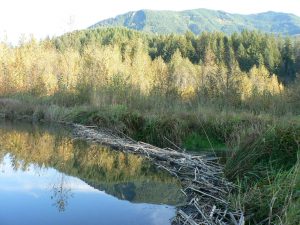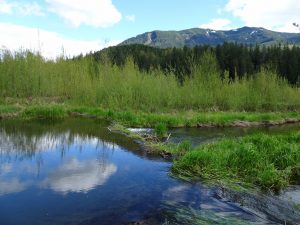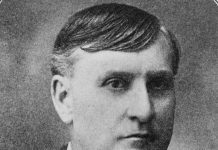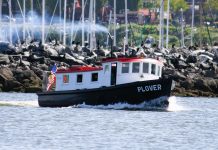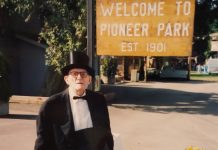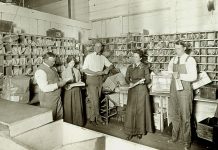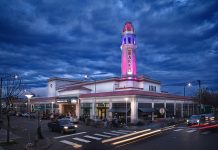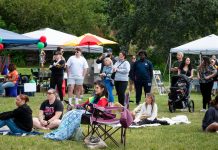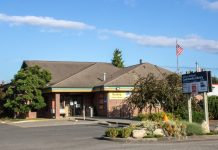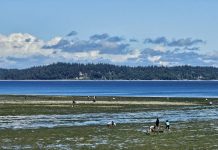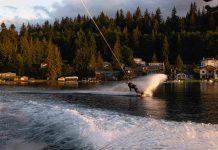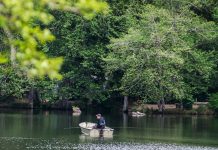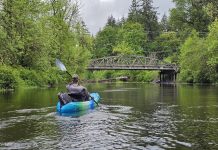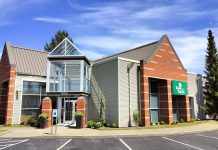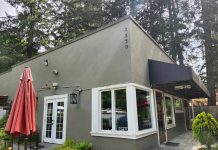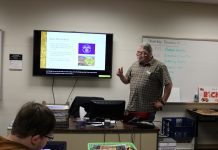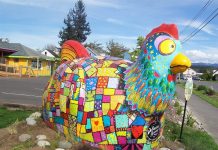On a mild, gray Earth Day morning, red-winged blackbirds flashed their colors and sang – konk-la-REE! – from the braiding creek. Volunteers huddled around coffee, pastries (generously donated from the Community Food Co-op) and a map. A rain-proof, human-sized county map, stretched tight across an event tent and speckled with orange, green and purple to show the land – all 20,760 acres, from working farms to wildlife habitats – that Whatcom Land Trust (WLT) conserves.
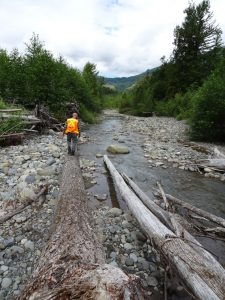
Daniel Senner, WLT’s interning Stewardship Associate, pointed out the purple plot where we stood, wedged between Mount Baker Highway, Maple Creek (just east of the town of Maple Falls) and the Nooksack River’s North Fork. “These particular 110 acres are great for wildlife,” Daniel said, “and one of the few Whatcom places where all five species of salmon – chum, coho, pink, sockeye, chinook…plus steelhead, cutthroat and bull trout – can thrive.”
As we turned from the map to the land itself, where shovels and buckets full of bare-root saplings lay on the wet grass, it was clear that this habitat was no accident. “Basically, our goal today is to grow big trees and let them interact with the river,” added Daniel’s mentor and WLT’s Stewardship Director, Eric Carabba.
While “big” is ideal, those of us who’ve volunteered with Eric before know the operative word is “interact.” More than strict outcomes, this is a place conserved to allow natural processes to occur. Here, winter can blow trees to the water, pooling and redirecting its flow. Beavers can be beavers, creating new channels and openings for the sun. The creek can flood its floodplain.
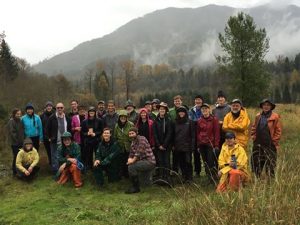
Ever since this land was cleared at the turn of the 20th century, then farmed for dairy cows and Christmas trees, people have known Maple Creek’s floodplain as a fickle place. But when WLT purchased this land over the first decade of the 21st century, they called it a “salmon’s dream stream,” a victory for the future of people and nature. As a non-profit organization, WLT works with willing landowners to purchase land or craft conservation easements that protect open space. In turn, places like Maple Creek Reach not only serve people diverse benefits – from carbon-storing trees to a sense of wonder – but they are places where people can serve. More than 20 WLT tree planting or weed pulling parties occur across the county each fall and spring, and in 2015-2016, volunteers racked up 1,347 hours of stewardship.
I’ve joined them for the last three years, and I’ve found Maple Creek an especially rewarding place to be part of the process and interact with others who love it. We are always a motley crew of one-timers and old-timers and those in between, welcoming all sorts of college students, church groups, singles, families and uncategorizables. The Earth Day work party turned out to be an especially moving one for me, because it was Eric’s last.
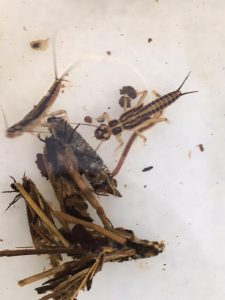
Born and raised in Whatcom’s South Fork Valley (another stronghold where WLT allies healthy farms, forests and water) Eric served with the Army, built trails and studied geography at Western Washington University before coming to WLT. After eleven years, he’s ready for his next big adventure, but with humor and heart he made each work party timeless for thousands of volunteers. Anyone planting with Eric could expect the best of Whatcom’s historical and ecological lore, and also the ethic to get stuff done with tools like shovels, Pulaskis and weed wrenches. He’ll be sorely missed but his work will grow on in all the people he’s empowered and the places he’s touched.
Sometimes I lose myself in my tree planting work, making sure the soil packs tight – but does not constrain – the precious roots. But a place like Maple Creek Reach brings out all kinds of skills, curiosities and surprises. As noon came near, WLT Board Member Carl Prince arrived and fired up a grill, toted out on the land for a special Earth Day picnic to honor our labors. It’s not every day that people have or take the chance to revel in good food and work, or even to muse on the quality of the dirt, the turn of the seasons or the tricks of the weather. Or the impromptu wonders of nature, like the aquatic macroinvertebrates that volunteer and professional-cum-citizen scientist Todd Folsom scooped up from Maple Creek.
I’m sure all fifty-some of us volunteers had other good ways to celebrate Earth Day, but getting nearly 500 trees and shrubs in the ground near Maple Creek was pretty hard to beat. We know that some might not survive if there’s not enough water this summer, or too much next winter. But there’s no doubt some will hold birds’ nests, or shade fish or feed beavers who will create even more habitat than we could imagine. Some might even become like the old “Nooksack Giant,” which towered not far from here. But each one, in its own way, will add to the map, changing this place and leaving us changed.
Contact WLT Volunteer Coordinator Dennis Connor if you want to get involved.
